Cole’s P.E. Buffet/Pacific Electric Building
1908 (Cole’s)
118 East Sixth Street – map
Declared: 10/18/72
1903 – Thornton Fitzhugh (building)
610 South Main – map
Declared: 10/17/89
Like Los Angeles Historic-Cultural Monument No. 103, No. 104 is split up into two different parts (at least, this time, they’re on the same site). The first, declared a monument back in 1972, is Cole’s P.E. Buffet, located on the ground floor of what was once the Pacific Electric Building. In 1989, the Cultural Heritage Commission amended its seventeen-year-old designation to include the building itself.
From L.A.'s Department of City Planning website.
Harry/Henry Cole founded his restaurant/saloon in 1908. Besides running the restaurant, Cole also offered the city’s first check-cashing service from the bar. In addition to the longevity, one of Cole’s claims to fame is that the French dipped sandwich was invented here. That could be the case, just don’t tell these people.
Today, Cole’s stands as the oldest continuously-operated restaurant in Los Angeles. Well, continuously operating when it is being operated, that is. The restaurant closed for renovations last March, shortly after being bought by downtown real estate developer Cedd Moses. Now, since the original HCM designation is supposed to protect Cole’s interior, we’ll have to wait and see how much of the inside – including the mahogany bar, Tiffany lampshades, and tables made of old railway cars (none of which I know was still around as of last March, yet was there at one point) – is changed when Moses reopens Cole’s, hopefully in time for its centennial celebration.
Hey, Cedd, what’s the latest?
LATimeMachines.com has a nice picture of the interior of Cole’s here.
Now, for the Pacific Electric Building.
The history of the Pacific Electric Railway Company can – and does – fill books. The "Floyd’s Notes" version goes like this:
Henry Huntington took over Eli Clark and Moses Sherman’s interurban rail line, incorporating the Pacific Electric Railway Company in the fall of 1901. Basically, it was Huntington’s intention to use the service as a way to sell real estate more than anything else.
Architect Thornton Fitzhugh was hired to design a massive terminal building at the corner of Sixth and Main Streets. Originally called the Huntington Building, here’s a picture of it under construction. (At least one man, 24-year-old iron worker Russell Morehouse, was killed during construction, falling from the fourth story.)
When the $1.7 million terminal opened January 12, 1905 (103 years ago today!), it was the biggest building in the west. Looking at the picture above, you can see how it dwarfs its neighbors (but it wouldn't for long.) Here’s what the Los Angeles Times had to say the day after the big opening:
Undoubtedly the handsomest trolley railroad station in the United States, that of the Pacific Electric is the Huntington Building, at Sixth and Main streets, was opened yesterday for the first time. All cars from Pasadena, Monrovia, Alhambra and San Gabriel on the northern division, Long Beach and other points on the southern division were run into the building. The traffic was handled without a hitch, and the automatic trolley turner worked to perfection. This device is the invention of chief Electrician Horace Anderson and his assistants, who have arranged many improvements in electrical appliances, fitting them to the particular needs of the Pacific Electric Railroad.
There used to be Yellow Cars and Red Cars, the former pretty much sticking to downtown, the latter traveling all over the place. For those of us less than, say, fifty years old, we can only imagine what it was like to ride streetcars from San Bernardino to Long Beach or San Fernando Valley to San Gabriel Valley for a handful of change.
Huntington sold out to the Southern Pacific in 1911 at which time the P.E. was consolidated with more than half a dozen other railway companies.
Here's the entrance to the old train shed, now the way to get into the parking lot for the Pacific Electric Lofts.
While the corporation eventually spread to four counties on more than 1,000 miles of track and became the world’s largest interurban railway (in 1923, the Red Cars carried more than 109 million riders), the Pacific Electric Railway was never a hugely profitable venture (it lost $2.8 million in 1919 alone).
"Hey! Look out! You're about to be hit by a streetcar!"
Until 1925, the Pacific Electric Building was also home to the Jonathan Club, occupying its top three floors. Restored today is the club’s rotunda on the eighth floor, now a library/lounge for residents of the Pacific Electric Lofts (more on them below). The old Jonathan Club ballroom on the ninth floor has been converted into three large loft units. (Here's a lousy picture of the rotunda today. And this is the wonderfully restored mosaic artwork in the rotunda.)
An old shopfront to the right of the former train shed entrance.
Bus service in and out of the Pacific Electric Building was introduced at the start of World War II and lasted for more than twenty years.
In 1944, Claude Beelman redesigned the building’s lobby in more of a Streamline style. Today, the lobby is renovated not so much in the original design but rather Beelman’s.
This is the back - the Los Angeles Street - side of the P.E. Building. Hopefully future restoration will include the opening up of the old arches hidden by, er, that stuff hiding the old arches. For a view of the other side of those old windows - now a parking garage - click here.
A day after the official last passenger trip of the Red Cars on April 8, 1961, the Electric Railway Historical Association chartered a two-car train from Long Beach to the P.E. Building and back as one last hurrah to end the Long Beach line. Freight continued to be moved on the Pacific Electric line for about four more years.
The rooftop garden.
Another view from the P.E. Building.
Since the summer of 2005, the old Huntington Building has been home to the Pacific Electric Lofts. You need to check out their website, as there’s a bit of history and even some interactive stuff available.
In November the Los Angeles Conservancy held a Mainly Main walking tour, in which a handful of landmarks on Main Street, including the P.E. Building, opened their doors for tour groups. I took a bunch of pictures inside HCM No. 104 that day (none was allowed on the ninth floor), but even the best (shown here) was pretty terrible. If the Conservancy gives you the opportunity to see the inside of the building again, take it.
Here's one final shot, taken from a window on one floor or another.
“Great Depot Open” Los Angeles Times; Jan 13, 1905
“Two Fearful Falls, Two Men Killed.” Los Angeles Times; Sep 10, 1903
Robert M. Fogelson The Fragmented Metropolis University of California Press 1967 Berkeley, Los Angeles, London
Spencer Crump Ride the Big Red Cars Trans-Anglo Books 1970 Costa Mesa, CA
Up next: Hiner House
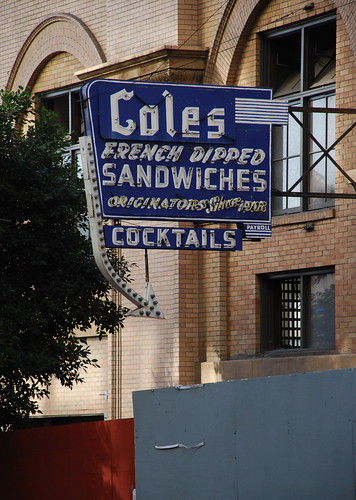
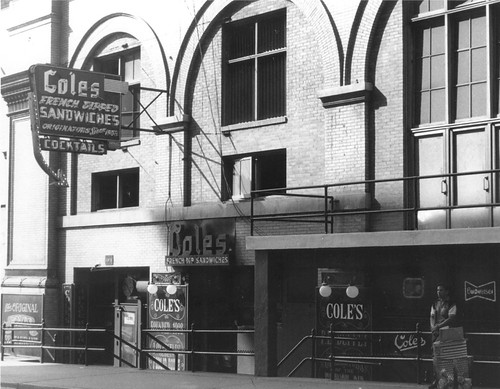
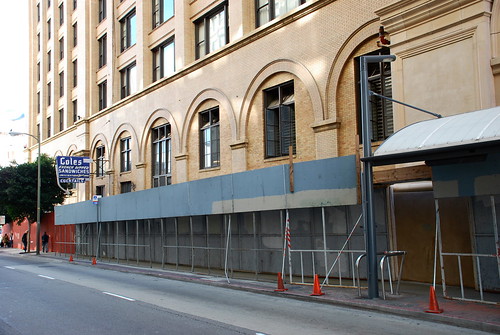
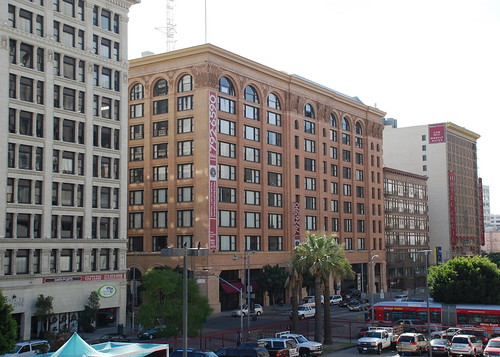
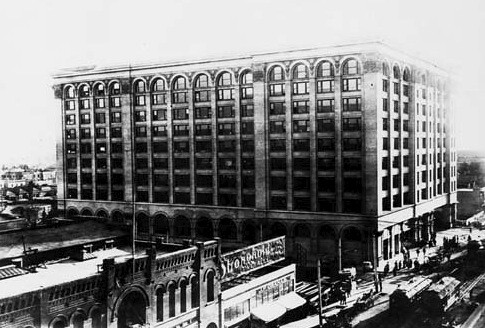
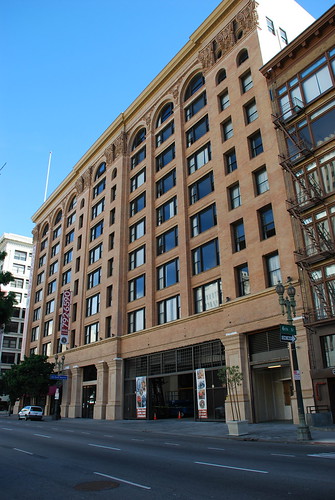
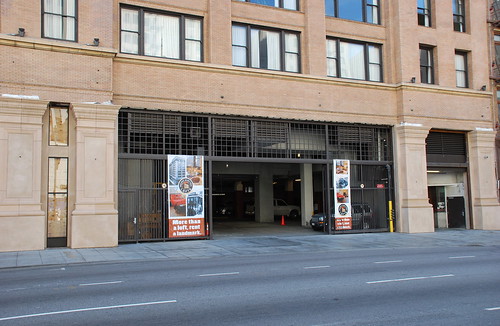
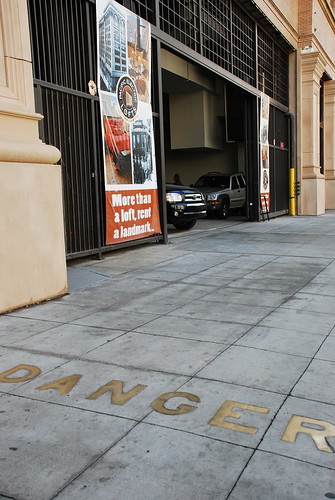
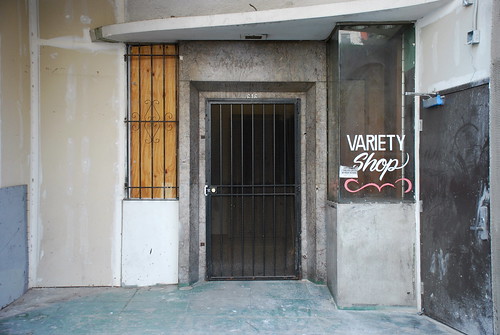
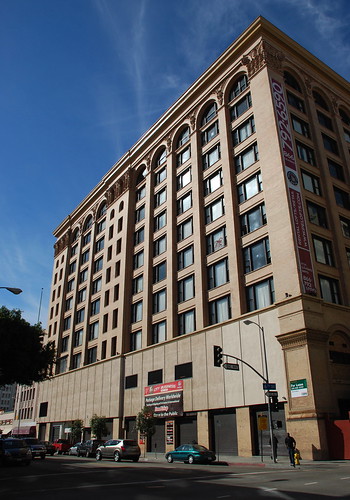
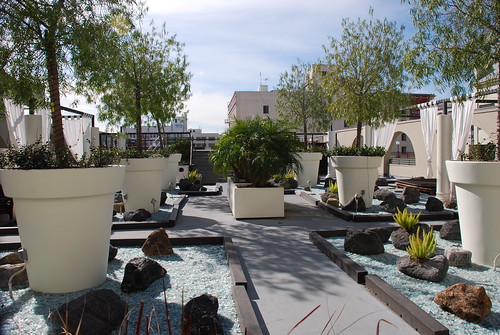
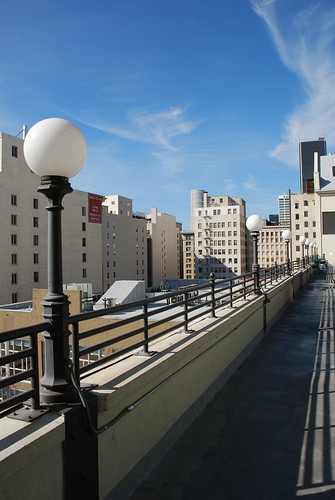
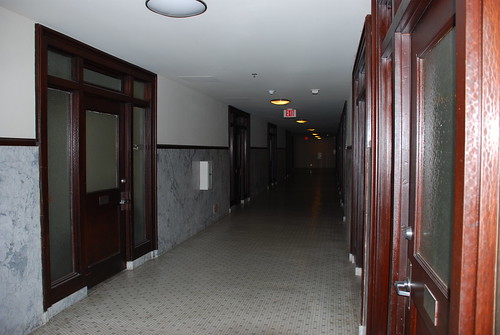
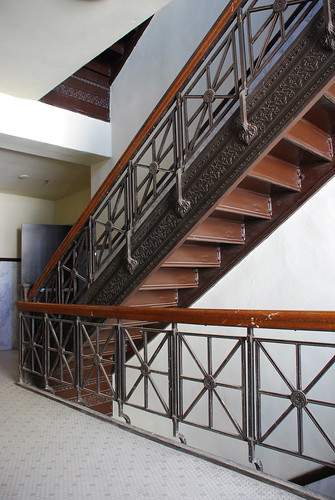
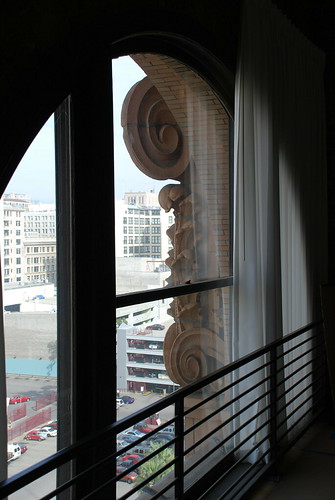
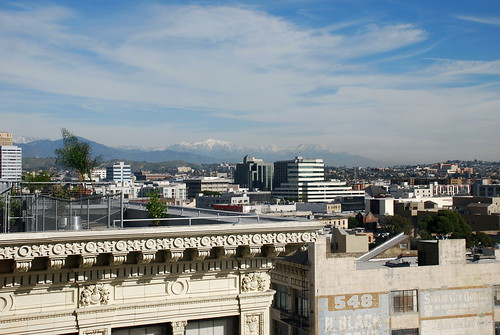

4 comments:
Also did the LA Conservancy's Mainly Main tour in November. This building alone was worth it all. I love that you can clearly see Mt. San Antonio (aka Mt Baldy) from the rooftop (last photo on post. What a great view.
Hi,
I some what agree to your article.
Finding an electrician shouldn’t be difficult. Locating the one that you believe is right for your project might not be quite as easy. If an electrician is in possession of a state license you can at least assume he working legally within the trade. When talking with Los Angeles electrician, ask to see a copy of his license. Call the local state contractors licensing board to verify any electrician’s license. You’ll also want proof of liability insurance and workers comp for the electrician and any employees and make certain all documents are up to date.
Thanks,
- Michelle Francis
Red Cars and Yellow cars defined...
The Red Cars were indeed the red interurban electric railway cars of the Pacific Electric Railway, and they graced the rear of the PE Building, on tracks that are long-gone. The platforms stuck out of the building's east side, second story and occupied the area that later became the Greyhound bus terminal and is now a big mercado behind the PE building.
The Yellow Cars were the narrow-gauge streetcars of the Los Angeles Railway, which ran down Main Street. The Los Angeles Railway and the Pacific Electric were not one-in-the-same...two separate systems with separate gauge track.
The PE became part of the Southern Pacific Railroad, and upon the demise of the PE's electric passenger service, much of the system survived as freight trackage throughout Los Angeles... not the "four more years" as described in this blog. In fact, a large portion of today's Metrolink San Bernardino line runs on ex-PE right-of way, most notably between a spot east of El Monte, and Claremont.
SP moved executive offices and a Southern California operations center into the PE building, and it served SP well into the 1980s, shortly before the railway's merger with Union Pacific. All of SP's rail network in Southern California was controlled by dispatchers in the old PE building.
Interestingly, much of the microwave equipment on the roof of the building was SP's--used for company communication. SP called this system the Southern Pacific Railroad INTertie, or Sprint, for short. In the 1980s, excess capacity on this microwave network was sold to the public as Sprint long distance service, and early subscribers actually write monthly checks to "SP Communications" in Burlinggame, CA. SP sold Sprint to GTE (now Verizon) in the late 1980s.
PE was owned outright by SP from 1911 to 1965 when PE was merged into parent SP. It was four years from when the last Red Car line ran, with the the Red Cars owned by MTA but operated on PE tracks, to when the merger took place.
The only standard gauge electric line in L.A. County tha didn't merge into the New PE in the 1911 Great Merger was the Glendale and Montrose Railway, which came under Union Pacific control.
Post a Comment